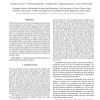Free Online Productivity Tools
i2Speak
i2Symbol
i2OCR
iTex2Img
iWeb2Print
iWeb2Shot
i2Type
iPdf2Split
iPdf2Merge
i2Bopomofo
i2Arabic
i2Style
i2Image
i2PDF
iLatex2Rtf
Sci2ools
ICASSP
2008
IEEE
2008
IEEE
Modulation analysis of speech through orthogonal FIR filterbank optimization
Newborns must learn to structure incoming acoustic information into segments, words, phrases, etc., before they can start to learn language. This process is thought to rely on modulation structure of the speech waveform induced by segmental or prosodic regularities within the speech heard by the infant. Here, we investigate the process by which the initial acoustic processing required by modulation analysis can itself be tuned by exposure to the regularities of speech. Starting from the classic definition of modulation, as applied within channels of the peripheral filter, we formulate a mathematical framework in which the structure of initial spectral filtering is adapted for modulation analysis. Our working hypothesis is that the human ear and brain are adapted to the analysis of modulation, via a data-driven learning process on the scale of development (or possibly evolution). Simulation results are presented and a comparison with filterbanks classically used in signal processin...
ICASSP 2008 | Initial Acoustic Processing | Modulation Analysis | Modulation Structure | Signal Processing |
| Added | 30 May 2010 |
| Updated | 30 May 2010 |
| Type | Conference |
| Year | 2008 |
| Where | ICASSP |
| Authors | Jonathan Le Roux, Hirokazu Kameoka, Nobutaka Ono, Shigeki Sagayama, Alain de Cheveigné |
Comments (0)

